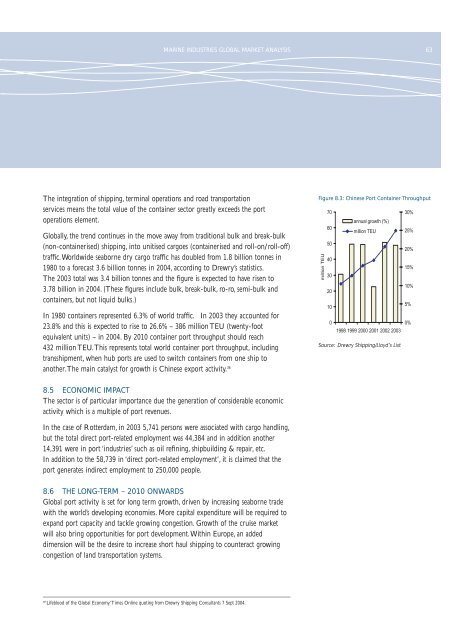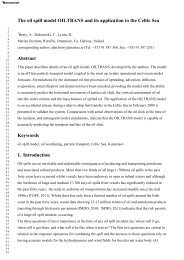Marine Industries Global Market Analysis - Marine Institute
Marine Industries Global Market Analysis - Marine Institute
Marine Industries Global Market Analysis - Marine Institute
Create successful ePaper yourself
Turn your PDF publications into a flip-book with our unique Google optimized e-Paper software.
MARINE INDUSTRIES GLOBAL MARKET ANALYSIS<br />
63<br />
The integration of shipping, terminal operations and road transportation<br />
services means the total value of the container sector greatly exceeds the port<br />
operations element.<br />
Figure 8.3: Chinese Port Container Throughput<br />
<strong>Global</strong>ly, the trend continues in the move away from traditional bulk and break-bulk<br />
(non-containerised) shipping, into unitised cargoes (containerised and roll-on/roll-off)<br />
traffic.Worldwide seaborne dry cargo traffic has doubled from 1.8 billion tonnes in<br />
1980 to a forecast 3.6 billion tonnes in 2004, according to Drewry’s statistics.<br />
The 2003 total was 3.4 billion tonnes and the figure is expected to have risen to<br />
3.78 billion in 2004. (These figures include bulk, break-bulk, ro-ro, semi-bulk and<br />
containers, but not liquid bulks.)<br />
In 1980 containers represented 6.3% of world traffic. In 2003 they accounted for<br />
23.8% and this is expected to rise to 26.6% – 386 million TEU (twenty-foot<br />
equivalent units) – in 2004. By 2010 container port throughput should reach<br />
432 million TEU.This represents total world container port throughput, including<br />
transshipment, when hub ports are used to switch containers from one ship to<br />
another.The main catalyst for growth is Chinese export activity. 36<br />
Source: Drewry Shipping/Lloyd’s List<br />
8.5 ECONOMIC IMPACT<br />
The sector is of particular importance due the generation of considerable economic<br />
activity which is a multiple of port revenues.<br />
In the case of Rotterdam, in 2003 5,741 persons were associated with cargo handling,<br />
but the total direct port-related employment was 44,384 and in addition another<br />
14,391 were in port ‘industries’ such as oil refining, shipbuilding & repair, etc.<br />
In addition to the 58,739 in ‘direct port-related employment’, it is claimed that the<br />
port generates indirect employment to 250,000 people.<br />
8.6 THE LONG-TERM – 2010 ONWARDS<br />
<strong>Global</strong> port activity is set for long term growth, driven by increasing seaborne trade<br />
with the world’s developing economies. More capital expenditure will be required to<br />
expand port capacity and tackle growing congestion. Growth of the cruise market<br />
will also bring opportunities for port development.Within Europe, an added<br />
dimension will be the desire to increase short haul shipping to counteract growing<br />
congestion of land transportation systems.<br />
36<br />
‘Lifeblood of the <strong>Global</strong> Economy’Times Online quoting from Drewry Shipping Consultants 7 Sept 2004.

















